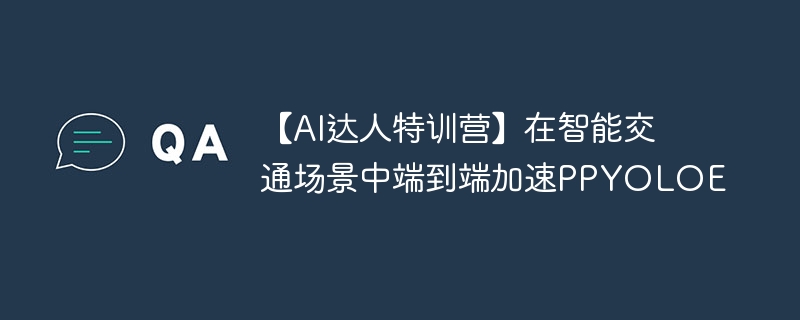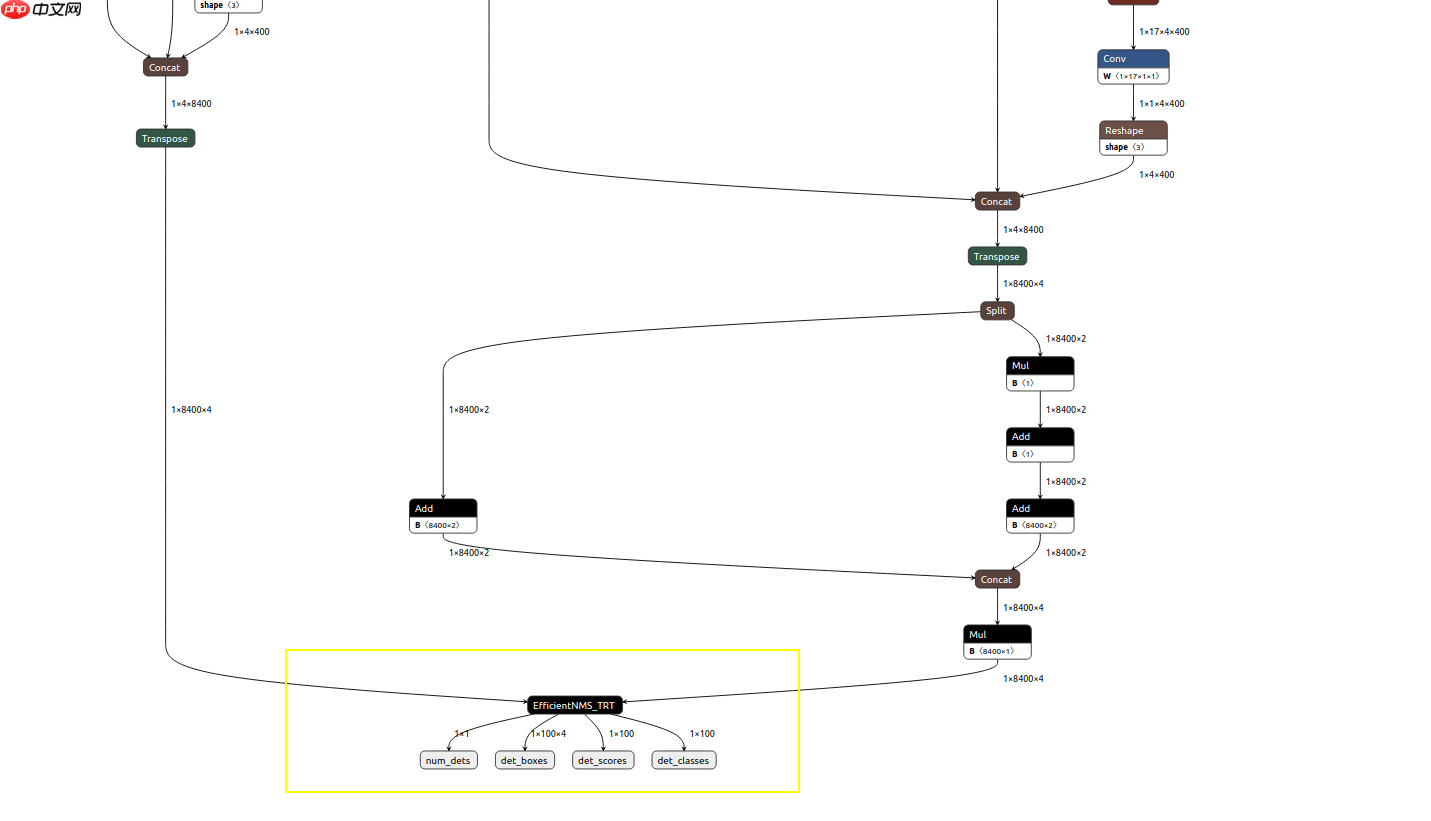本项目针对城市自动驾驶中基于车载摄像头的交通灯小目标识别挑战,采用PaddleDetection套件的PPYOLOE M模型训练,在A100环境实现。使用特定数据集训练,涵盖红、黄、绿、未亮灯四类。通过TensorRT加速,将NMS封装进模型实现端到端加速,A100上FP16达330FPS,较官方数据提升显著,适用于PPYOLOE系列算法。
☞☞☞AI 智能聊天, 问答助手, AI 智能搜索, 免费无限量使用 DeepSeek R1 模型☜☜☜

红绿灯识别对于在城市地区的全自动驾驶至关重要,基于车载摄像头的交通灯识别中,目标表现为小目标,问题有较大的挑战性。本项目对常见场景中的交通信号灯进行识别, 使用飞桨提供的目标检测套件PaddleDetection,训练目标检测模型,同时考虑到算法真实落地的需求,介绍了基于TensorRT的模型加速流程,相比与官方给出的测试数据有较大的提升。本项目的相关技术实现适用于PPYOLOE系列算法的所有模型,希望通过此项目介绍能推动PPYOLOE这个高性能模型的应用。[本项目仅适用与 A100环境]
数据集详情如下
trafficlight/ ├── code │ ├── json_merge.py # 用于json合并 │ ├── json_split.py # 按一定比例将json分成两份 ├── img_without_anno │ ├── 45张没有标注信息的交通灯图片 ├── JPEGImages │ ├── 2226张没有标注信息的交通灯图片 ├── train.json ├── eval.json
训练集:{‘4’: 1304, ‘5’: 108, ‘6’: 1744, ‘7’: 3174} 验证集:{‘4’: 312, ‘5’: 31, ‘6’: 469, ‘7’: 748} 其中4表示红灯,5表示黄灯,6表示绿灯,7表示未亮灯
# 解压数据集!unzip -oq /home/aistudio/data/data153372/trafficlight.zip -d /home/aistudio/data/data153372
import jsonimport osimport randomimport matplotlib.pyplot as plt import cv2from PIL import Image
num_image = 20json_path = 'data/data153372/trafficlight/train.json'img_path = 'data/data153372/trafficlight/JPEGImages'with open(json_path) as annos:
annotation_json = json.load(annos)# 统计json文件的关键字长度print('the annotation_json num_key is:', len(annotation_json))# 读出json文件的关键字print('the annotation_json key is:', annotation_json.keys())# json文件中包含的图片数量print('the annotation_json num_images is:', len(annotation_json['images']))# 获取所有类别数categories = annotation_json['categories']
categories_dict = {c['id']: c['name'] for c in categories}
class_nums = len(categories_dict.keys())print('class name', categories_dict.keys())
color = [(random.randint(0, 255), random.randint(0, 255),
random.randint(0, 255)) for _ in range(class_nums)]# 读取图像image_name = annotation_json['images'][num_image - 1]['file_name']
img_id = annotation_json['images'][num_image - 1]['id']
image_path = os.path.join(img_path, str(image_name).zfill(5))
image = cv2.imread(image_path, 1)
annotations = annotation_json['annotations']
num_bbox = 0for anno in annotations: if anno['image_id'] == img_id:
num_bbox = num_bbox + 1
class_id = anno['category_id']
class_name = categories_dict[class_id]
class_color = random.choice(color) # 绘制边框
x, y, w, h = list(map(int, anno['bbox']))
cv2.rectangle(image, (int(x), int(y)),
(int(x + w), int(y + h)),
class_color, 2) # 绘制文本
font_size = 0.7
txt_size = cv2.getTextSize(class_name, cv2.FONT_HERSHEY_SIMPLEX,
font_size, 1)[0]
cv2.rectangle(image, (x, y + 1),
(x + txt_size[0] + 10, y - int(2 * txt_size[1])),
class_color, -1)
cv2.putText(image, class_name, (x + 5, y - 5),
cv2.FONT_HERSHEY_SIMPLEX,
font_size, (255, 255, 255), 1)print('The unm_bbox of the display image is:', num_bbox)# 保存可视化图即可the annotation_json num_key is: 3 the annotation_json key is: dict_keys(['images', 'annotations', 'categories']) the annotation_json num_images is: 1781 class name dict_keys([4, 5, 6, 7]) The unm_bbox of the display image is: 3
Image.fromarray(image[:, :, ::-1])
<PIL.Image.Image image mode=RGB size=1920x1080 at 0x7F4B4457AC50>

 简介
简介PaddleDetection为基于飞桨PaddlePaddle的端到端目标检测套件,内置30+模型算法及250+预训练模型,覆盖目标检测、实例分割、跟踪、关键点检测等方向,其中包括服务器端和移动端高精度、轻量级产业级SOTA模型、冠军方案和学术前沿算法,并提供配置化的网络模块组件、十余种数据增强策略和损失函数等高阶优化支持和多种部署方案,在打通数据处理、模型开发、训练、压缩、部署全流程的基础上,提供丰富的案例及教程,加速算法产业落地应用。

 特性
特性# 拉取代码!git clone https://gitee.com/paddlepaddle/PaddleDetection.git
fatal: 目标路径 'PaddleDetection' 已经存在,并且不是一个空目录。
### 配置PaddleDetectionabs!rm -rf PaddleDetection/configs/ !cp -r configs/ PaddleDetection %cd PaddleDetection !pip install -r requirements.txt !python setup.py install
!ln -s ~/data/data153372/trafficlight dataset/trafficlight
模型方面,采用了PPYOLOE M 模型作为检测器
首先PP-YOLOE-l 在COCO数据集上达到了51.4mAP。相比较PP-YOLOv2提升1.9AP和13.35%的速度,相比较YOLOX提升1.3AP和24.96%的速度。
主要的改进点是:

超参数配置文件ppyoloe_trafficlight.yml
_BASE_: [ '../datasets/traffic.yml', '../runtime.yml', './_base_/optimizer_300e.yml', './_base_/ppyoloe_crn.yml', './_base_/ppyoloe_reader.yml',
]log_iter: 100snapshot_epoch: 10epoch: 300weights: output/ppyoloe_trafficlight/model_finalfind_unused_parameters: Truepretrain_weights: https://paddledet.bj.bcebos.com/models/ppyoloe_crn_m_300e_coco.pdparamsdepth_mult: 0.67width_mult: 0.75TrainReader:
batch_size: 16LearningRate:
base_lr: 0.0001
schedulers:
- !CosineDecay
max_epochs: 360
- !LinearWarmup
start_factor: 0.00001
steps: 2300数据集traffic.yml
metric: COCOnum_classes: 4TrainDataset: !COCODataSet image_dir: JPEGImages anno_path: train.json dataset_dir: dataset/trafficlight data_fields: ['image', 'gt_bbox', 'gt_class', 'is_crowd']EvalDataset: !COCODataSet image_dir: JPEGImages anno_path: eval.json dataset_dir: dataset/trafficlightTestDataset: !ImageFolder anno_path: eval.json # also support txt (like VOC's label_list.txt) dataset_dir: dataset/trafficlight # if set, anno_path will be 'dataset_dir/anno_path'
# 训练模型,采用VD可视化 混合精度训练!python -m paddle.distributed.launch --gpus 0 tools/train.py -c configs/ppyoloe/ppyoloe_trafficlight.yml --eval --use_vd True --amp
Average Precision (AP) @[ IoU=0.50:0.95 | area= all | maxDets=100 ] = 0.356 Average Precision (AP) @[ IoU=0.50 | area= all | maxDets=100 ] = 0.594 Average Precision (AP) @[ IoU=0.75 | area= all | maxDets=100 ] = 0.380 Average Precision (AP) @[ IoU=0.50:0.95 | area= small | maxDets=100 ] = 0.261 Average Precision (AP) @[ IoU=0.50:0.95 | area=medium | maxDets=100 ] = 0.571 Average Precision (AP) @[ IoU=0.50:0.95 | area= large | maxDets=100 ] = 0.438 Average Recall (AR) @[ IoU=0.50:0.95 | area= all | maxDets= 1 ] = 0.263 Average Recall (AR) @[ IoU=0.50:0.95 | area= all | maxDets= 10 ] = 0.503 Average Recall (AR) @[ IoU=0.50:0.95 | area= all | maxDets=100 ] = 0.509 Average Recall (AR) @[ IoU=0.50:0.95 | area= small | maxDets=100 ] = 0.432 Average Recall (AR) @[ IoU=0.50:0.95 | area=medium | maxDets=100 ] = 0.695 Average Recall (AR) @[ IoU=0.50:0.95 | area= large | maxDets=100 ] = 0.526
在检测模型中后处理需要用到NMS算法,在项目使用TensorRT加速YOLOv6-Python笔者介绍了如何使用TRT加速一个检测模型,在该项目中,导出ONNX模型时并没有包含NMS(paddledetection导出包含NMS的ONNX模型无法转换到TRT序列化模型),因此NMS 的实现需要得到结果后再进行一次后处理,这样导致模型的推理速度较慢(相比于接下来介绍的端到端加速方案)。接下来我们将介绍如何将NMS封装到模型内部,实现端到端的模型加速。
# 导出模型、onnx模型!pip install onnxruntime onnx paddle2onnx
!python tools/export_model.py -c configs/ppyoloe/ppyoloe_trafficlight.yml --output_dir=inference_model -o weights=output/ppyoloe_trafficlight/best_model.pdparams trt=True exclude_nms=True estReader.inputs_def.image_shape=[3,640,640]
!paddle2onnx --model_dir inference_model/ppyoloe_trafficlight/ --model_filename model.pdmodel --params_filename model.pdiparams --opset_version 13 --save_file ppyoloe.onnx --input_shape_dict "{'image':[1, 3, 640, 640], 'scale_factor': [1, 2]}"!python3 -m pip install --upgrade setuptools pip --user !pip install -U numpy !pip install -U onnx !python3 -m pip install nvidia-pyindex !python3 -m pip install --upgrade nvidia-tensorrt !pip install pycuda !pip install onnx_graphsurgeon !pip install onnx-simplifier
使用Netron检查得到的ONNX模型,得到节点信息。
节点Mul_100,Concat_14对应模型的目标框和置信度,如下图,通过onnx_graphsurgeon将TRT支持的NMS插件注册到模型中
原始ONNX模型
注册NMS模型
%cd /home/aistudio/
/home/aistudio
import onnximport onnx_graphsurgeon as gsimport numpy as npfrom onnx import shape_inferencefrom collections import OrderedDictimport onnxsim
## 注册NMSw = './PaddleDetection/ppyoloe.onnx'gs_graph = gs.import_onnx(onnx.load(w))# fold constantsgs_graph.fold_constants()
gs_graph.cleanup().toposort()
Mul_100 = [node for node in gs_graph.nodes if node.name=='Mul_100'][0]
Concat_14 = [node for node in gs_graph.nodes if node.name=='Concat_14'][0]
scores = gs.Variable(name='scores',shape=[1,8400,4],dtype=np.float32)
Transpose = gs.Node(name='lastTranspose',op='Transpose',
inputs=[Concat_14.outputs[0]],
outputs=[scores],
attrs=OrderedDict(perm=[0,2,1]))
gs_graph.nodes.append(Transpose)
Mul_100.outputs[0].name = 'boxes'gs_graph.inputs = [gs_graph.inputs[0]]
gs_graph.outputs = [Mul_100.outputs[0],scores]
gs_graph.outputs[0].dtype=np.float32
gs_graph.outputs[1].dtype=np.float32
gs_graph.cleanup().toposort()
onnx_graph = shape_inference.infer_shapes(gs.export_onnx(gs_graph))
onnx_graph, check = onnxsim.simplify(onnx_graph)
gs_graph = gs.import_onnx(onnx_graph)
op_inputs = gs_graph.outputs
op = "EfficientNMS_TRT"attrs = { "plugin_version": "1", "background_class": -1, "max_output_boxes": 100, "score_threshold": 0.25, "iou_threshold": 0.45, "score_activation": False, "box_coding": 0,
}
output_num_detections = gs.Variable(
name="num_dets",
dtype=np.int32,
shape=[1, 1],
)
output_boxes = gs.Variable(
name="det_boxes",
dtype=np.float32,
shape=[1, 100, 4],
)
output_scores = gs.Variable(
name="det_scores",
dtype=np.float32,
shape=[1, 100],
)
output_labels = gs.Variable(
name="det_classes",
dtype=np.int32,
shape=[1, 100],
)
op_outputs = [
output_num_detections, output_boxes, output_scores, output_labels
]
TRT = gs.Node(op=op,name="batched_nms",inputs=op_inputs,outputs=op_outputs,attrs=attrs)
gs_graph.nodes.append(TRT)
gs_graph.outputs = op_outputs
gs_graph.cleanup().toposort()
onnx.save(gs.export_onnx(gs_graph),'./ppyoloe_nms.onnx')print('Add NMS')Add NMS
import tensorrtprint(tensorrt.__version__)assert tensorrt.Builder(tensorrt.Logger())
8.4.1.5
!python export.py -o ppyoloe_nms.onnx -e ppyoloe_nms_fp16.trt -p fp16
import numpy as npimport cv2import timeimport osimport tensorrt as trtimport pycuda.autoinitimport pycuda.driver as cuda trt.init_libnvinfer_plugins(None,'') # 使用NMS 插件
True
class BaseEngine(object):
def __init__(self, engine_path):
logger = trt.Logger(trt.Logger.WARNING)
runtime = trt.Runtime(logger) with open(engine_path, "rb") as f:
serialized_engine = f.read()
engine = runtime.deserialize_cuda_engine(serialized_engine)
self.context = engine.create_execution_context()
self.inputs, self.outputs, self.bindings = [], [], []
self.stream = cuda.Stream() for binding in engine:
size = trt.volume(engine.get_binding_shape(binding))
dtype = trt.nptype(engine.get_binding_dtype(binding))
host_mem = cuda.pagelocked_empty(size, dtype)
device_mem = cuda.mem_alloc(host_mem.nbytes)
self.bindings.append(int(device_mem)) if engine.binding_is_input(binding):
self.inputs.append({'host': host_mem, 'device': device_mem}) else:
self.outputs.append({'host': host_mem, 'device': device_mem}) def infer(self, img):
self.inputs[0]['host'] = np.ravel(img) # transfer data to the gpu
for inp in self.inputs:
cuda.memcpy_htod_async(inp['device'], inp['host'], self.stream) # run inference
self.context.execute_async_v2(
bindings=self.bindings,
stream_handle=self.stream.handle) # fetch outputs from gpu
for out in self.outputs:
cuda.memcpy_dtoh_async(out['host'], out['device'], self.stream) # synchronize stream
self.stream.synchronize()
data = [out['host'] for out in self.outputs] return datadef preproc(image, input_size, mean, std, swap=(2, 0, 1)):
if len(image.shape) == 3:
padded_img = np.ones((input_size[0], input_size[1], 3)) * 114.0
else:
padded_img = np.ones(input_size) * 114.0
img = np.array(image)
r = min(input_size[0] / img.shape[0], input_size[1] / img.shape[1])
resized_img = cv2.resize(
img,
(int(img.shape[1] * r), int(img.shape[0] * r)),
interpolation=cv2.INTER_LINEAR,
).astype(np.float32)
padded_img[: int(img.shape[0] * r), : int(img.shape[1] * r)] = resized_img
padded_img = padded_img[:, :, ::-1]
padded_img /= 255.0
if mean is not None:
padded_img -= mean if std is not None:
padded_img /= std
padded_img = padded_img.transpose(swap)
padded_img = np.ascontiguousarray(padded_img, dtype=np.float32) return padded_img, r
_COLORS = np.array(
[ 0.000, 0.447, 0.741, 0.850, 0.325, 0.098, 0.929, 0.694, 0.125, 0.494, 0.184, 0.556, 0.466, 0.674, 0.188
]
).astype(np.float32).reshape(-1, 3)def vis(img, boxes, scores, cls_ids, conf=0.5, class_names=None):
for i in range(len(boxes)):
box = boxes[i]
cls_id = int(cls_ids[i])
score = scores[i] if score < conf: continue
x0 = int(box[0])
y0 = int(box[1])
x1 = int(box[2])
y1 = int(box[3])
color = (_COLORS[cls_id] * 255).astype(np.uint8).tolist()
text = '{}:{:.1f}%'.format(class_names[cls_id], score * 100)
txt_color = (0, 0, 0) if np.mean(_COLORS[cls_id]) > 0.5 else (255, 255, 255)
font = cv2.FONT_HERSHEY_SIMPLEX
txt_size = cv2.getTextSize(text, font, 0.4, 1)[0]
cv2.rectangle(img, (x0, y0), (x1, y1), color, 2)
txt_bk_color = (_COLORS[cls_id] * 255 * 0.7).astype(np.uint8).tolist()
cv2.rectangle(
img,
(x0, y0 + 1),
(x0 + txt_size[0] + 1, y0 + int(1.5 * txt_size[1])),
txt_bk_color,
-1
)
cv2.putText(img, text, (x0, y0 + txt_size[1]), font, 0.4, txt_color, thickness=1) return imgclass Predictor(BaseEngine):
def __init__(self, engine_path , imgsz=(640,640)):
super(Predictor, self).__init__(engine_path)
self.imgsz = imgsz
self.class_names = [ 'Traffic Light-Red Light', 'Traffic Light-Yellow Light', 'Traffic Light-Green Light', 'Traffic Light-Off'] def inference(self, img_path):
origin_img = cv2.imread(img_path)
mean = (0.485, 0.456, 0.406)
std = (0.229, 0.224, 0.225)
img, ratio = preproc(origin_img, self.imgsz, mean, std)
num, final_boxes, final_scores, final_cls_inds = self.infer(img)
final_boxes = np.reshape(final_boxes, (-1, 4))
num = num[0] if num >0:
final_boxes, final_scores, final_cls_inds = final_boxes[:num]/ratio, final_scores[:num], final_cls_inds[:num]
origin_img = vis(origin_img, final_boxes, final_scores, final_cls_inds,
conf=0.3, class_names=self.class_names)
cv2.imwrite("%s_ppyoloe.jpg" % os.path.splitext(
os.path.split(img_path)[-1])[0], origin_img)
def get_fps(self):
# warmup
img = np.ones((1,3,640,640))
img = np.ascontiguousarray(img, dtype=np.float32) for _ in range(20):
_ = self.infer(img)
t1 = time.perf_counter()
_ = self.infer(img) print(1/(time.perf_counter() - t1), 'FPS')pred = Predictor(engine_path='ppyoloe_nms.trt') pred.get_fps()
[07/07/2022-11:27:45] [TRT] [W] TensorRT was linked against cuDNN 8.4.1 but loaded cuDNN 8.2.0 [07/07/2022-11:27:45] [TRT] [W] TensorRT was linked against cuDNN 8.4.1 but loaded cuDNN 8.2.0 199.98711579598273 FPS
pred.inference('data/data153372/trafficlight/img_without_anno/08015.jpg')
结果展示
YOLOE-M End2End
| Device | FP32 | FP16 | int8 |
|---|---|---|---|
| A100 | 224FPS | 330FPS | - |
| 1080Ti | 101FPS | 103FPS | 171FPS |
Origin
| 模型 | GPU个数 | 每GPU图片个数 | 骨干网络 | 输入尺寸 | Box APval 0.5:0.95 |
Box APtest 0.5:0.95 |
Params(M) | FLOPs(G) | V100 FP32(FPS) | V100 TensorRT FP16(FPS) | 模型下载 | 配置文件 |
|---|---|---|---|---|---|---|---|---|---|---|---|---|
| PP-YOLOE-s | 8 | 32 | cspresnet-s | 640 | 43.0 | 43.2 | 7.93 | 17.36 | 208.3 | 333.3 | model | config |
| PP-YOLOE-m | 8 | 28 | cspresnet-m | 640 | 49.0 | 49.1 | 23.43 | 49.91 | 123.4 | 208.3 | model | config |
| PP-YOLOE-l | 8 | 20 | cspresnet-l | 640 | 51.4 | 51.6 | 52.20 | 110.07 | 78.1 | 149.2 | model | config |
| PP-YOLOE-x | 8 | 16 | cspresnet-x | 640 | 52.3 | 52.4 | 98.42 | 206.59 | 45.0 | 95.2 | model | config |
可以发现使用端到端的加速策略,模型的推理速度有较大的提升在V100上模型FP32的推理速度远高于官方版本给出的baseline
以上就是【AI达人特训营】在智能交通场景中端到端加速PPYOLOE的详细内容,更多请关注php中文网其它相关文章!

每个人都需要一台速度更快、更稳定的 PC。随着时间的推移,垃圾文件、旧注册表数据和不必要的后台进程会占用资源并降低性能。幸运的是,许多工具可以让 Windows 保持平稳运行。

Copyright 2014-2025 https://www.php.cn/ All Rights Reserved | php.cn | 湘ICP备2023035733号